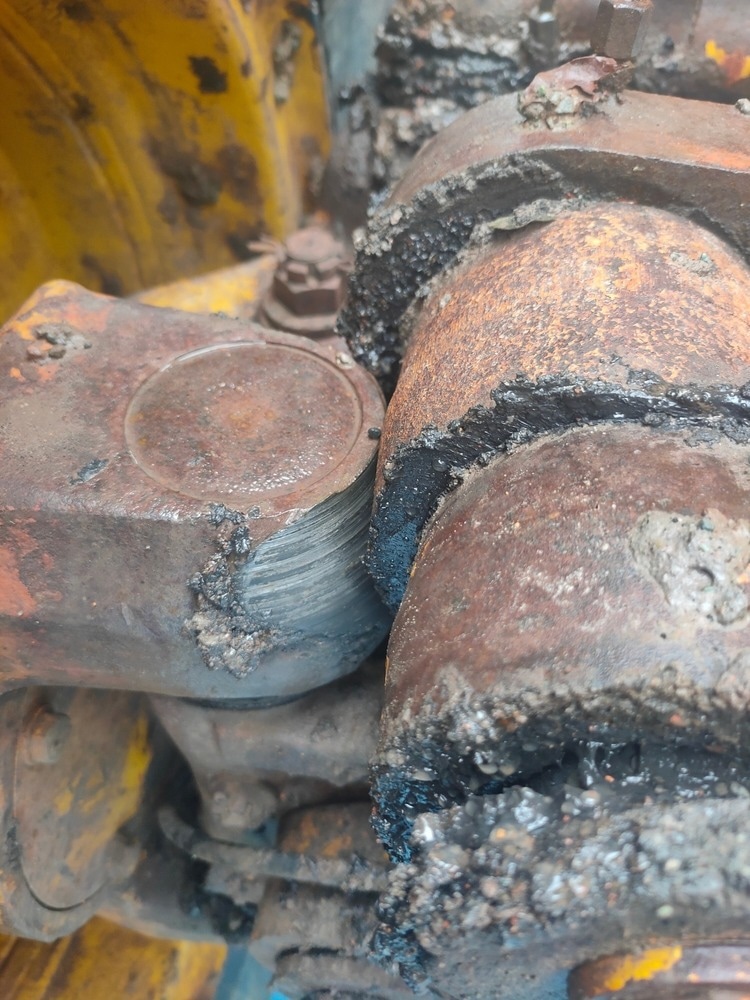A recent article published in Advanced Functional Materials investigated the friction behavior of surfaces coated with surface-attached hydrogel layers. These natural synovial-joint structure-inspired hydrogels were prepared using photoinduced carbon-hydrogen (C-H) insertion crosslinking (CHic) chemistry from hydrogel precursor polymers and simultaneously linked to two sliding surfaces.

Metal worn by friction. Image Credit: Creat69/Shutterstock.com
Background
Friction and wear consume approximately 25% of the world's energy and produce significant carbon dioxide (CO2) emissions. Therefore, various synthetic or natural lubricants are required to lower friction and wear. However, most current lubricants are oil-based, with difficult recycling and substantial environmental problems.
A key feature of the friction system is that, while viscosity in the normal force direction should be high to prevent squeezing out of the aqueous lubricant, the shear friction must be low to resist excess energy dissipation and wear. Nature provides a solution to this dilemma.
Natural joints consist of cartilage, a complex hydrogel structure, and synovial fluid, a water-based lubricant. Several efforts have been made to realize low-friction surfaces inspired by such natural examples. Specifically, hydrogels on both surfaces have gained considerable attention as water is partially squeezed out of the hydrogel layers upon compression, generating superlubricious surfaces.
Methods
To generate C-H bonds, cleaned glass slides were modified with a self-assembled layer of 3-triethoxysilyl propyloxybenzophenone by dip coating and annealed for 30 min at 120 °C.
The silanized glass slides were coated using viscous solutions of poly dimethylacrylamide-co-methacryloyloxy-benzophenone P(DMAA-co-x% MABP) or PDMAA-Co-MABP-co-sodium styrenesulfonate (PDMAA-Co-MABP-co-SSNa).
The crosslinker content x was varied as 1, 2.5, 5, and 10%, confirmed using nuclear magnetic resonance measurements.
Subsequently, the samples were crosslinked in an ultraviolet chamber with a high energy dose to initiate the CHic reaction and C-C bond formation.
The layers were extracted by ethanol post-irradiation to remove unlinked and unreacted chains from the network.
A white light interferometer was used to determine film thicknesses in wet and dry states and the roughness of the surface-attached hydrogels.
The mechanical properties of the surface-attached hydrogels were examined via atomic force microscopy. Force-indentation curves were derived by recording force and penetration depth as the load was varied from zero to maximum force and back to zero.
The force-indentation curves were fitted for a spherical cantilever (Hertz theory) to determine Young's modulus and penetration depth for each hydrogel. Finally, durability and friction tests were performed on the surface-attached hydrogels using a nanotribometer.
Results and Discussion
The surface-attached hydrogels exhibited only one-dimensional swelling due to crosslinking in the solid state and exceptional frictional properties when both surfaces were covered with these layers.
Specifically, in the swelling test performed in water for 30 min, the hydrogel with 1% MABP exhibited a swelling ratio of ≈8, which was relatively high but dropped to 3–4 with 10% MABP.
Since the layers were anisotropically swollen, they did not allow interpenetration and entanglement of the chains grafted to the opposite surfaces, thereby exhibiting no adhesion. As the load increased, compressing the gels further became more difficult to compress and squeeze out more water. Consequently, the frictional force increased only gradually with the load, and the already low coefficient of friction became even lower.
The hydrogel samples with higher crosslink density had a higher friction coefficient and a significant stick-slip behavior, which was attributed to the better system lubrication due to more water. Additionally, the entropic barrier minimized adhesion between the contact surfaces, preventing the two opposing surfaces from sticking.
The friction coefficients could be further reduced by adding a shear-thinning polymer (mimicking synovial fluid) to the aqueous solution, exhibiting a ≈99.5% reduction in friction compared to the unmodified glass surfaces. Therefore, the friction coefficients of the proposed hydrogels were in the superlubricity regime and even outperformed the values often reported for natural joints when added with 10% polyacrylamide.
Conclusion
The researchers successfully demonstrated the application of surface-attached hydrogel layers to generate super-lubricious surfaces. They evaluated the frictional behavior of such gel-coated samples under different conditions and compared the frictional behavior of neutral versus polyelectrolyte hydrogels.
As the crosslinking was performed in the dry state and all polymer chains were covalently bound to the surface, the hydrogel layers could only swell in one direction, resulting in strong chain stretching. This confinement led to surfaces with ultralow adhesion and strongly reduced friction.
Incorporating charges and shear-thinning polymers into the water phase allowed for the generation of friction systems with friction coefficients of 0.002–0.001, thus reaching superlubricity and even surpassing the values reported for natural models.
Therefore, surface-attached hydrogel layers in strong confinement, exhibiting only one-dimensional swelling, are promising for replacing conventional oils if water evaporation can be prevented.
The loading limits and durability of the proposed hydrogel systems should be further explored for practical applications.
Disclaimer: The views expressed here are those of the author expressed in their private capacity and do not necessarily represent the views of AZoM.com Limited T/A AZoNetwork the owner and operator of this website. This disclaimer forms part of the Terms and conditions of use of this website.
Source:
Maraula, R., Bahrami, M., Jafari, S., Prucker, O., Amann, T., & Rühe, J. (2025). Superlubricious Surfaces Through Surface Attached Hydrogels Obtained by C,H‐insertion Crosslinking. Advanced Functional Materials. DOI: 10.1002/adfm.202420624, https://advanced.onlinelibrary.wiley.com/doi/10.1002/adfm.202420624